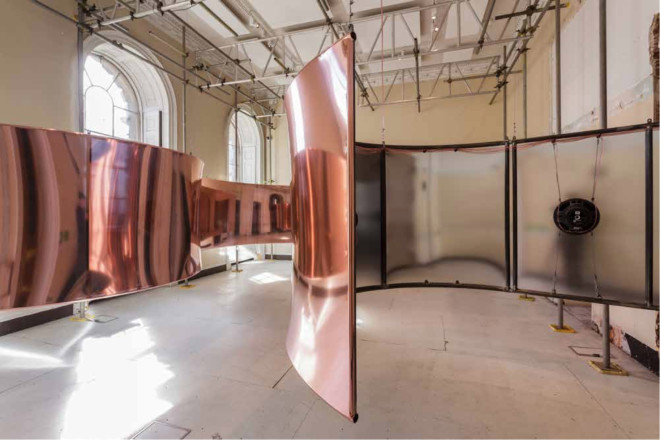“The new Passat Highline Plus with leather seats as standard … [The view of the moon through a roadkill hedge] is a glimpse of the grey-eyed madness of you,” sings a man’s voice, electronically distorted for a time. The word “you” reverberates a few times and eventually falls silent. The film “Gush” (2018), which is being presented by British artist Hannah Perry in the coming Double Feature, then shows a young man standing under a shower, who looks directly into the lens.
“I think it’s always difficult to say what you are good at. No likes,” it continues. Strings, which sound almost distorted due to the way they are being played, fill the audio with a bleak-seeming drone sound, while the voiceover continues to meander away: “Drifting from one idea to another”, “Wait – everything hurt, nothing was beautiful”, “Could I have said one small thing to make you happy?” “Gush” deals with loss and trauma, as Hannah Perry (born 1984) explained in an interview with “The Art Newspaper”.
In 2016, her close friend, the artist Pete Morrow, whom she met at Goldsmith University in London and subsequently collaborated repeatedly, took his own life. “I wasn’t prepared for the trauma or the horror of it all. [It was] violently shocking in its extreme,” Perry said in the interview, recalling that traumatic time.
I wasn’t prepared for the trauma or the horror of it all.

“Gush” was part of the exhibition of the same name, which was staged last year at London’s Somerset House. In the installation “Rage Fluids”, which formed part of it, stretched sheet metal was made to vibrate through low-frequency sounds, whereby the mirror images of the observers on the smooth surfaces were distorted into abstract shapes. The video piece “Gush”, which is a good 20 minutes long, was screened on a circular canvas in the exhibition.
The images distort the material and leave behind an inner chaos
Here, Perry combines 360° footage she filmed herself with found footage, as well as archive shots from nighttime journeys through the city, parties with friends, or scrap yards. The images of the 360-degree camera skew the recorded material and thus cause disorientation, which is triggered by an excess of pictorial information of all things – a surprising effect, since generally one could assume that a 360-degree view would offer a better grasp of the situation. The immersion becomes an obstacle, engulfs the observer and becomes an expression of the inner chaos that breaks out.

Hannah Perry, RAGE FLUIDS (GUSH @ SOMERSET HOUSE), 2018, Copyright The Artist, Image via townereastbourne.org.uk

Perry, who visibly carries the camera in her hands, is always divided into two halves – one part of her body on the left, one on the right of the screen – while she strides through rooms or up and down streets. The music, meanwhile, a collaboration between the London Contemporary Orchestra and members of the CURL collective, Coby Sey and Mica Levi, oscillates between melancholy-sentimental and somber, seething pieces.
The script oscillates between thoughts, slogans and Facebook posts
Perry’s script, which takes inspiration from her friend’s diary entries as well as from the workshops she organized with students from London South East College, is rendered by various speakers on the film’s audio. It appears to shift between personal thoughts, recited slogans and Facebook posts. The spoken words run continuously, but remain hard to grasp, and in their form refer to the title of the work: Gush.


In terms of the muddle they create, these “gushes” imply the difficulty, perhaps even the impossibility, of talking about topics such as mental health, grief or trauma within society. “Hannah, we care about you and the memories that you share here. We thought that you’d like to look back on this post from eight years ago,” is heard repeatedly, and it dawns on one slightly just how much the social platforms can complicate the processing of trauma by confronting us suddenly and unexpectedly with personal content from a few years ago.
Hannah, we care about you and the memories that you share here. We thought that you’d like to look back on this post from eight years ago.
As an additional film, Hannah Perry has chosen “Withnail and I” by British director Bruce Robinson. The film was released in 1987 and tells the story of a friendship between two penniless actors in London in the late 1960s. With no wages and nothing to eat, they spend their time in their dilapidated apartment in Camden Town and kill time with drugs, oblivious to how the divides between aspiration and reality can be so enormous.
The film draws a memorable image of friendship
To escape their misery, they plan to flee at least temporarily to a small house in northern England, which belongs to Withnail’s uncle. Yet country life also has its pitfalls: The house, which has seen better days, does little to shelter the two actors from the extremes of the weather, and the locals are untrusting of the two strangers. When eventually Uncle Monty comes to visit, the situation escalates. The film is based on an unpublished novel by its director Bruce Robinson, in which he deals with his experiences as a young actor.


Withnail and I, 1987, Filmstill, Image via www.bfi.org.uk
In its eloquence and tragicomedy, one might interpret “Withnail & I” as a farewell to the period of awakening that was the late 1960s. At the same time, the relationship between Withnail and the nameless “I” character harbors a kind of perceptive ambivalence which, despite the supposedly comedic atmosphere, emerges in the sophisticated dialog and presents a memorable picture of the friendship between the protagonists. For Hannah Perry, the film also has a very personal significance: She watched it over and over with her best friend Pete Morrow while he was alive.

Withnail and I, 1987, Film still, Image via wordpress.com
